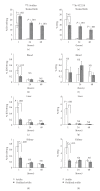OXavidin for tissue targeting biotinylated therapeutics
- PMID: 20130784
- PMCID: PMC2814378
- DOI: 10.1155/2009/921434
OXavidin for tissue targeting biotinylated therapeutics
Abstract
Avidin is a glycoprotein from hen egg white that binds biotin with very high affinity. Here we describe OXavidin, a product containing aldehyde groups, obtained by ligand-assisted sugar oxidation of avidin by sodium periodate. OXavidin chemically reacts with cellular and tissue proteins through Schiff's base formation thus residing in tissues for weeks while preserving the biotin binding capacity. The long tissue residence of OXavidin as well as that of OXavidin/biotinylated agent complex occurs in normal and neoplastic tissues and immunohistochemistry shows a strong and homogenous stromal localization. Once localized in tissue/tumor, OXavidin becomes an "artificial receptor" for intravenous injected biotin allowing tumor targeting with biotinylated therapeutics like radioisotopes or toxins. Moreover, present data also suggest that OXavidin might be useful for the homing of biotinylated cells. Overall, OXavidin exhibits a remarkable potential for many different therapeutic applications.
Figures







Similar articles
-
Biochemical and biological characterization of a new oxidized avidin with enhanced tissue binding properties.J Biol Chem. 2010 Mar 19;285(12):9090-9. doi: 10.1074/jbc.M109.080457. Epub 2010 Jan 25. J Biol Chem. 2010. PMID: 20100839 Free PMC article.
-
AvidinOX™ for tissue targeted delivery of biotinylated cells.Int J Immunopathol Pharmacol. 2012 Jan-Mar;25(1):239-46. doi: 10.1177/039463201202500126. Int J Immunopathol Pharmacol. 2012. PMID: 22507336
-
Antibody fragments in tumor pretargeting. Evaluation of biotinylated Fab' colocalization with recombinant streptavidin and avidin.Bioconjug Chem. 1996 Nov-Dec;7(6):689-702. doi: 10.1021/bc9600628. Bioconjug Chem. 1996. PMID: 8950488
-
Avidin-biotin technology in targeted therapy.Expert Opin Drug Deliv. 2010 May;7(5):551-64. doi: 10.1517/17425241003677749. Expert Opin Drug Deliv. 2010. PMID: 20233034 Review.
-
The principles and applications of avidin-based nanoparticles in drug delivery and diagnosis.J Control Release. 2017 Jan 10;245:27-40. doi: 10.1016/j.jconrel.2016.11.016. Epub 2016 Nov 16. J Control Release. 2017. PMID: 27865853 Free PMC article. Review.
Cited by
-
Intra-tumor AvidinOX allows efficacy of low dose systemic biotinylated Cetuximab in a model of head and neck cancer.Oncotarget. 2016 Jan 5;7(1):914-28. doi: 10.18632/oncotarget.6089. Oncotarget. 2016. PMID: 26575422 Free PMC article.
-
AvidinOX-anchored biotinylated trastuzumab and pertuzumab induce down-modulation of ErbB2 and tumor cell death at concentrations order of magnitude lower than not-anchored antibodies.Oncotarget. 2017 Apr 4;8(14):22590-22605. doi: 10.18632/oncotarget.15145. Oncotarget. 2017. PMID: 28186982 Free PMC article.
-
Biochemical and biological characterization of a new oxidized avidin with enhanced tissue binding properties.J Biol Chem. 2010 Mar 19;285(12):9090-9. doi: 10.1074/jbc.M109.080457. Epub 2010 Jan 25. J Biol Chem. 2010. PMID: 20100839 Free PMC article.
-
Therapeutic efficacy of intra-tumor AvidinOX and low systemic dose biotinylated cetuximab, with and without cisplatin, in an orthotopic model of head and neck cancer.Oncol Lett. 2019 Mar;17(3):3529-3536. doi: 10.3892/ol.2019.10003. Epub 2019 Feb 1. Oncol Lett. 2019. PMID: 30867794 Free PMC article.
-
Radionuclide Therapy of Unresectable Tumors with AvidinOX and (90)Y-biotinDOTA: Tongue Cancer Paradigm.Cancer Biother Radiopharm. 2015 Sep;30(7):291-8. doi: 10.1089/cbr.2015.1837. Epub 2015 Jul 13. Cancer Biother Radiopharm. 2015. PMID: 26167947 Free PMC article.
References
-
- Muhic A, Hovgaard D, Mørk Petersen M, et al. Local control and survival in patients with soft tissue sarcomas treated with limb sparing surgery in combination with interstitial brachytherapy and external radiation. Radiotherapy and Oncology. 2008;88(3):382–387. - PubMed
-
- MacDermed DM, Weichselbaum RR, Salama JK. A rationale for the targeted treatment of oligometastases with radiotherapy. Journal of Surgical Oncology. 2008;98(3):202–206. - PubMed
-
- Kim Y, Johnson M, Trombetta MG, Parda DS, Miften M. Investigation of interfraction variations of MammoSite balloon applicator in high-dose-rate brachytherapy of partial breast irradiation. International Journal of Radiation Oncology Biology Physics. 2008;71(1):305–313. - PubMed
-
- Kaufman SA, DiPetrillo TA, Price LL, Midle JB, Wazer DE. Long-term outcome and toxicity in a Phase I/II trial using high-dose-rate multicatheter interstitial brachytherapy for T1/T2 breast cancer. Brachytherapy. 2007;6(4):286–292. - PubMed
-
- Saito S, Nagata H, Kosugi M, Toya K, Yorozu A. Brachytherapy with permanent seed implantation. International Journal of Clinical Oncology. 2007;12(6):395–407. - PubMed
MeSH terms
Substances
LinkOut - more resources
Full Text Sources
Other Literature Sources
Medical

